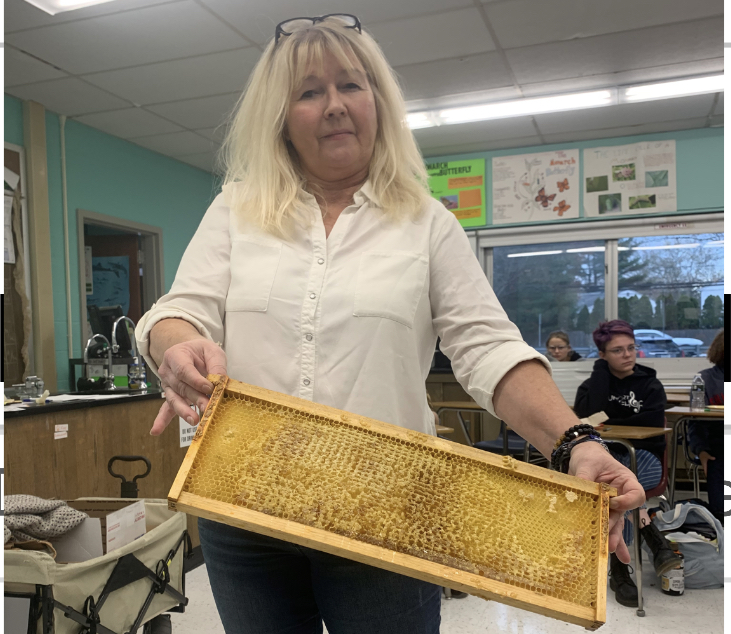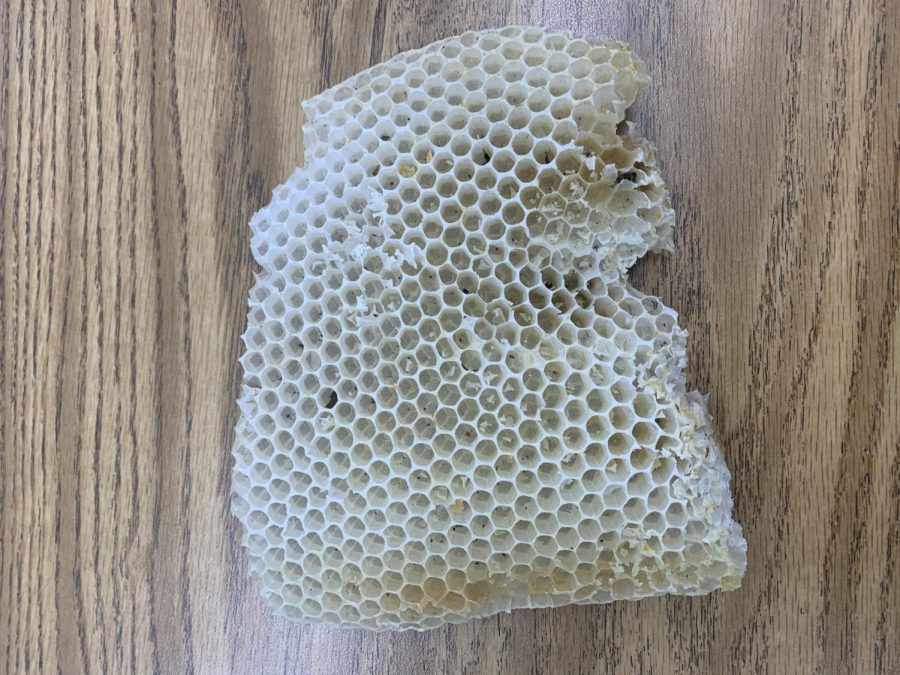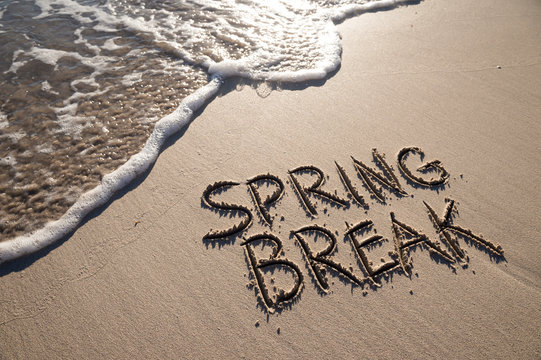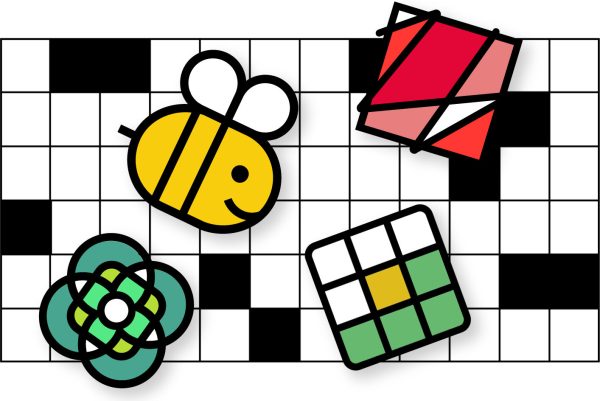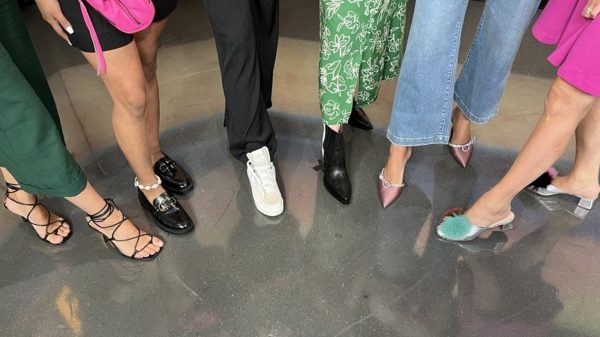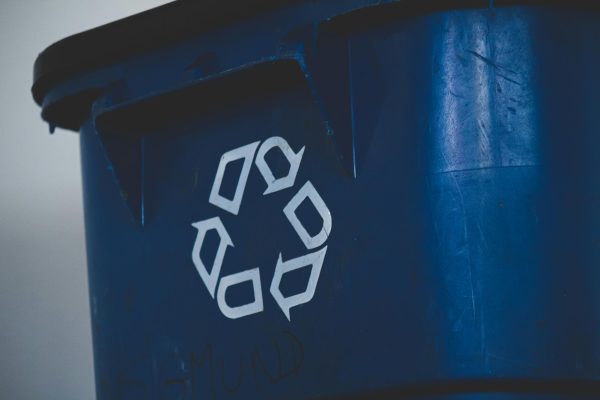Bee-utiful Bees: How anyone can become a beekeeper
November 25, 2019
Disclaimer: This article provides a brief overview of the basics of beekeeping, and is not intended to be one’s only source of information if he or she decides to foster a hive of his or her own. Additionally, one should be completely aware of the risks associated with keeping bees, and it is the sole responsibility of a hive owner to keep themselves safe while tending to their hive.
Bees. These little black and yellow buzzers are the bane of many a summertime picnicker and avid outdoorsman. They’re small, noisy, and they pack a nasty punch if allowed to sting a victim. But as much as the general populous may dislike or even fear bees, without them many of the things we humans take for granted would cease to exist. Bees are responsible for pollinating nearly a 3rd of all food we as humans eat, such as apples, almonds, broccoli, and strawberries, accounting for a total of about $15 billion worth of crops in the US. About 80% of European wildflowers rely on bees for pollination, making bees an absolute necessity to the health and stability of wild ecosystems. And, of course, no conversation about the benefits of bees is complete without mentioning their most well-known product: honey. Honey is the only food that we get exclusively from insects, and it’s got a whole host of amazing properties. It’s chock-full of plant compounds, natural antioxidants, and even some vitamins, it has the sweetness of sugar with much less of the negative health effects, it helps improve cholesterol and lower blood pressure, and it can even help heal burns and wounds. Plus, it never goes bad, so it’s safe to keep one jar for years on end (provided you don’t eat it all at once). But despite all the amazing things bees do to help us humans out, we don’t seem to be returning the favor very well. Habitat destruction, deforestation, pesticide use, and the spread of invasive species have all contributed to an approximate yearly hive loss of 30-50% in the US– substantially more than is considered normal. Additionally, out of the nearly 4000 wild bee species that inhabit the US, about 1000 are at risk of extinction. Bees are critically important creatures to both mankind and the natural world, and no other living thing on this planet can afford to lose them. So what can we do to help reverse this dangerous decline? That’s where beekeepers come in.
Beekeeping, simply put, is the act of fostering one’s own beehive on their property in order to gather honey. And, despite the continued prevalence of bee-phobia in our society, the art of beekeeping is becoming increasingly popular in the US. And, with the right knowledge and materials, anyone can become a beekeeper themselves. Fortunately for us here at NHS, our very own naturalist extraordinaire, Mrs. Byler of the Friends of the Greenhouse group, recently invited a local beekeeper in to share some words of wisdom with any aspiring apian enthusiasts. Katherine Redman, a mother of two and professional Wall Street financial adviser, is a local beekeeper with a great passion for her art. As someone who works closely with these insects, Mrs. Redman understands just how important bees are to the natural world and hopes to spark a continued interest in beekeeping among her fellow Northportians. This article will present a summary of some of the most important pieces of beekeeping know-how, as well as some of the biggest benefits that one can enjoy from having their own hive.
First off, some basic info. Raising a beehive is no small undertaking, with an average beehive containing around 60,000 bees by the end of a single summer. This means that there is most certainly always a risk of getting stung, especially if one is not wearing proper beekeeping attire. Thankfully, because bees die when they sting, they only use this defense mechanism if they are sure their target is a dire threat. “They don’t just sting you for the heck of it,” Mrs. Redman points out. Additionally, an observant beekeeper can generally tell when a hive is excited due to an increase in the volume of their buzz; if this occurs, it’s probably best to leave. Avoiding a hive while upset is also a good choice, as bees can detect excess carbon dioxide released due to heavy or stressed breathing. Of course, apart from keeping oneself safe, keeping a hive healthy should be the next biggest priority. One way to accomplish this is by keeping the property on which a hive is located as natural and wild as possible. “On Long Island, we are constantly concerned about making sure that our lawns are green and weed-free,” says Mrs. Redman, “but of course, it’s the weed-free part that is most damaging to bees.” Bees love all sorts of plants that we humans generally remove from our lawns, such as dandelions, bee balm, and dead-nettles. Leaving these plants in one’s lawn can greatly increase the chances of having a successful and productive hive. Having a wide array of different plants on a property also contributes to the flavor of honey, as different types of pollen can give the honey different tastes. Also, using pesticides like DDT or Roundup (or even simply having a neighbor nearby that uses those chemicals) can cause damage to hives, so avoiding them entirely is optimal. Unfortunately, one of the biggest threats to beehives is also one of the harder pitfalls to avoid; that being parasites, specifically the Varroa mite. “You used to just be able to be a beekeeper, and have honey bees, and take the honey off once a year,” says Mrs. Redman, “and suddenly you have these little mites that can come out of nowhere and decimate a hive.” Varroa mites came over from Europe to the US in the mid 90’s, and since then have proven to be quite a nuisance to beekeepers across the country. A hive afflicted with these parasites will eventually die, so it’s crucial to take all necessary steps to prolong the survival of a bee population. A variety of methods can be used to help clear out a Varroa mite infestation, such as oxalic acid vaporization and chemical strips, but action must be taken fast to extend a hive’s survivability.
Next, a bit about setting up and maintaining a hive. To start, a perspective beekeeper should always research local regulations about owning bees, and inform nearby households of their intentions. Once it is clear that owning a hive won’t be a problem in one’s neighborhood, the next step is to purchase equipment. The most commonly-bought beehive type is the Langstroth hive, which holds 10 frames of honeycomb. When full of honey, however, 10 frames of honeycomb can weigh up to 60 pounds, which means that many may want to purchase 8-frame hives instead. Safety equipment, such as a bee suit and bee smoker (a device that calms bees through the release of smoke), are also things a new beekeeper should be sure to buy. Another helpful tool to have is a honeycomb roller- a paint roller-like device covered in small plastic prongs that can puncture through the capping wax that bees put over cells once they are full of honey. Of course, the most important component in a beehive is, well, the bees. Bees can be purchased in swarms which can then be transferred into a newly-constructed hive. Often, it is advisable to keep the queen bee separate from the rest of the hive until all other bees have already been transferred. Every hive has only one queen bee, and she will emit pheromones to alert the others in the hive to her importance. Thus, it is important to give the hive time to adjust to her presence, and to accept her as the “VIP” of the bee colony. The queen’s two primary purposes are to regulate the unity of her hive, and to produce as many eggs as possible. “I mark my queens,” says Mrs. Redman, “I actually catch them and put a dot of paint on them- pink, purple, something bright. Because you always want to be able to spot your queen.” All bees in a colony are female, except for the drone bees which only serve to reproduce with the queen, and then die. Thus, it is not uncommon to see many dead bees at the bottom of a hive at the end of the fall. A queen bee can lay up to 1200 eggs a day; thus, a hive can grow very rapidly if kept in optimal conditions. “If a hive gets too crowded, you’ll get a swarm,” Mrs. Redman notes, “especially if you don’t keep adding supers.” (supers being the box in which frames of honeycomb are held). Additionally, a selective barrier called a queen excluder can be used to keep queens from entering honey supers and laying eggs. At the end of a season, it is advised to leave at least 60 pounds of honey for the bees to sustain themselves off of through the winter. A successful hive will produce significantly over 100 pounds of honey, meaning that leaving some honey as food for a hive will not detract much from the amount that is actually harvested. Somewhere around January, bees begin to make brood, or babies, once again beginning the hive cycle over.
Finally, let’s look at some of the economic virtues of owning one’s own beehive. As mentioned before, honey is an incredibly nutritious food, not to mention a delicious one. Unfortunately for many fans of the superfood, the stuff we buy in supermarkets may not be all that super after all. Due to the way in which the FDA classifies “honey,” companies can get away with mixing small amounts of honey with substantially higher amounts of sugar and water. Not to mention the fact that whatever little amounts of honey are to be found in these products is likely imported from thousands of miles away. In order to actually get a product that can reasonably be called honey, one must either buy it from local beekeepers and farmers markets, or simply produce it themselves. And for those willing to do the latter, the fruits of their labor can be sold for quite a pretty penny- “100 pounds, $20 a pound, you do the math,” says Mrs. Redman. Additionally, the beeswax caps removed from honeycombs during the honey-harvesting process can be melted down, purified, and then sold to those looking to make things like beeswax candles. Though the initial cost of beginning a hive can be rather expensive, the returns later on more than make up for that down payment.
Bees are truly marvelous creatures that get a needlessly bad rap as aggressive little stinging machines that do nothing else but bother us humans. They are absolutely vital to the stability of every ecosystem in which they are found, and it is rather unfortunate that they are so underappreciated by the average person. Hopefully, with the help of people like Mrs. Redman and others, more people will begin to understand the many merits of getting involved in beekeeping and will decide to raise hives of their own.

